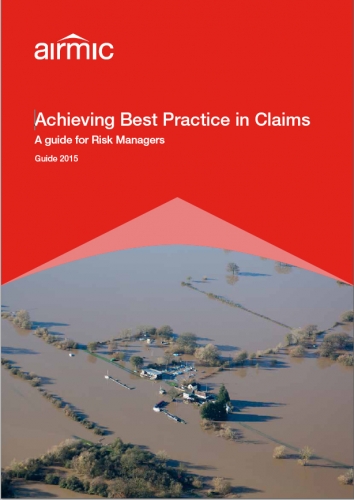Claims Best Practice Guide
Introduction
The objective for an organisation is to achieve a claims handling approach that ensures claims are managed in a consistent, flexible and fair manner. The claims handling approach must feedback into the organisation informing continuous improvements in claims performance, insurance programme relevance and the organisation’s overall risk and incident management.
Risk manager surveys consistently reveal that claims-related issues are one of their biggest concerns. Claims outcomes are ultimately the acid test of any insurance programme so effective claims handling is a vital issue for policyholders and insurers alike.
In 2009, Airmic released ‘Delivering Excellence in Insurance Claims Handling’, a best practice framework for insurers to assess the capabilities of their claims services. However, to see an overall improvement in claims performance, excellence needs to start within the organisation themselves.
As Karen Dawson, Assistant Insurance Manager at BAM Construct, advises; “Organisations that invest in a quality resource consisting of an experienced claims professional will consistently be able to demonstrate improvements in claims outcomes, possibly including a reduction in claims spend. However, risk and insurance managers have difficulties in convincing their boards of the importance of this.”
This updated guide builds upon Airmic’s earlier framework to provide practical guidance for the insured’s own insurance and claims team to evaluate is overall approach to claims handling in a structured and objective way.
Airmic recognises the wide range of claims handling arrangements and risk transfer structures utilised by Airmic members. This guide is predominantly directed at Airmic members who have some responsibility for claims handling. However, the overall principles and considerations are the same whether claims handling remains in-house or is outsourced to a third party. The overall objective is to achieve a claims handling approach both internally, and through effective partnerships with insurers, brokers and other service providers, that ensures claims are managed in a consistent, yet flexible and fair manner.
Structure of the guide
The guide is structured to provide information on eight key components that must be in place in order to achieve excellence in claims handling. The eight components are as follows:
- Culture and philosophy
- Structure
- Infrastructure
- People
- Claims procedures
- Communication
- Data management
- Monitoring and performance review
Section 1 of the guide outlines the meaning and importance of each component before proposing a list of considerations for the in-house team to assess its own operations and how it integrates its claims handling approach with that of its insurer and service providers. As well as evaluating current performance, the guide can also be used as a means of identifying areas for improvement.
Section 2 of the guide reinforces the need for in-house insurance and claims managers to ensure best practice not only within their own operations, but also within the service providers they engage with. Claims manager Angela Doran advises: “One of my pet grievances is that insurance companies tend to get involved only once a claim has already arisen, by which point time is a scarce commodity.” Section 2 proposes a list of key topics to be discussed during insurer selection and placement, to ensure that effective and efficient claims procedures are agreed and understood at the outset of the policy.
- Fill out an application Our membership manager will assess your eligibility against our criteria.
- Complete your profileIf you are eligible for membership you will be asked to answer a few questions about yourself.
- PaymentYou can make payment online using a card or request an invoice.

